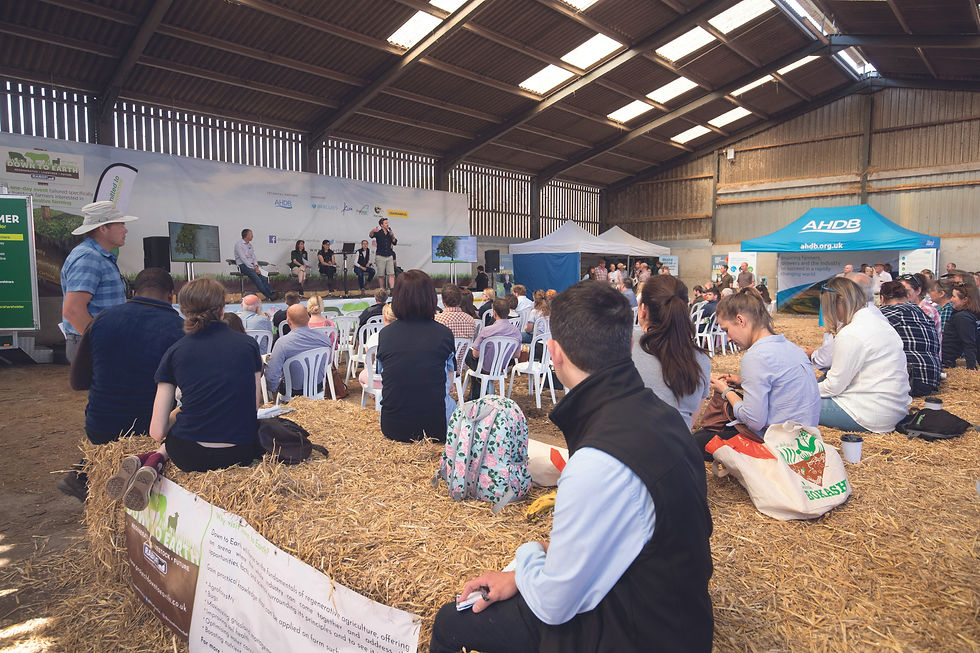Event underlines need for joined-up approach (July/Aug 22)
- CowManagement

- Aug 24, 2022
- 4 min read
An impressive turnout highlighted producers’ interest in reducing their businesses’ carbon footprint and, as speakers at Down to Earth underlined, it will take an industry-wide approach.
TEXT PHIL EADES

While many producers are confused about how to make a start on the journey to net zero, in no small part a consequence of the plethora of carbon calculators being promoted and the confusing messages on emissions, there is certainly interest in the principles of regenerative farming. More than 1,500 people attended RABDF’s first Down to Earth event in June, held at Tim Downes’ Shropshire-based unit. And, judging by attendee numbers and feedback, it won’t be the last. A combination of speakers and practical demonstrations helped clarify the objectives, principles and benefits of following a regenerative approach.
It focuses on improving soil health and restoring degraded soils. Proponents claim it can have significant benefits for farming practices and contribute practically to carbon reductions.
Soil health
Harper Adams University’s Jude Capper emphasised that the UK must continue to produce food in the most sustainable manner, and that increasing soil health will be key to this.
“Soil is a finite resource, having taken thousands of years to build up. All the food we eat, with the exception of fish, comes directly or indirectly from the soil. There is a huge opportunity to increase soil carbon to mitigate the carbon contribution from farming activities,” she told visitors during her presentation on regenerative principles and sustainability.

Jude Capper: "Every unit can adopt the principles and make progress"
“We need to demonstrate our success in doing this so that agriculture is seen as a positive influence. The way we will do this is to measure more and use this data to not only help make changes but also to demonstrate successes.”
Professor Capper stressed that animals are integral to sustainable farming because they are central to nutrient recycling and help make best use of land. “Adopting regenerative agriculture will contribute to producing enough food, mitigate greenhouse gas emissions and meet the UN’s sustainability goals. The good news is that every unit, even the most intensively-run systems, can adopt the principles and start to make progress,” she said. “But these principles need to be evidence based and aligned to the farm’s overall goals.”
Review systems
Speakers at the event agreed that while regenerative and circular farming had benefits, it was important to review systems. Kite Consulting’s John Allen said this may involve reversing the trend to specialised units and a return to mixed farming systems. “There will need to be more cows in the east while producers in the west will need to grow more crops.” Dunbia’s Sarah Haire added that many of the principles of regenerative farming actually have their foundations in the Norfolk four-course rotation.

A series of practical demonstrations allowed attendees to understand some of the principles that could be successfully and quite easily be applied on farm, allowing a first tentative step into regenerative farming. “Improving soil health is about understanding soil chemistry, physics and biology,” said Sustainable Soil Management’s Ian Robertson. “Soil chemistry is well understood. It’s about providing the nutrients required for the growing crop, while soil physics relates to issues such as compaction.
“Soil biology is harder to see, but is vital,” he stressed. Producers need to build good populations of the various soil organisms, whether they be earthworms, bacteria, fungi, or any of the other species that are critical for soil processes. It’s not the case that if soil physics and chemistry are right then the biology will improve, but they can help.
“Removing compaction, for example, is essential. Roots can’t break up compaction – steel is needed for this. But if compaction is broken up then plant roots can go deeper, and this will stimulate microbe populations,” said Mr Robertson.
“Similarly, if we reduce cultivations and the application of water-soluble nutrients, we can change the microbial balance and improve crop response and growth. Well-managed grassland is usually associated with better soil biology.”

As with any area of management, measuring is essential to make the most of soils and build soil health, and Promar’s Alistair Johnson urged all producers to invest in regular soil testing. He recommended testing soils every year to take account of nutrient availability and pH, and to compare this with the quality of the crop extracted. He also emphasised that the more producers know about the soils the better the farm and business can be managed. “Crop removal means nutrients are not available to be recycled and will need to be replenished,” he said. “Understanding the soil makes it easier to feed crops for the target level of productivity, applying only the nutrients that are required. This may allow a reduction in purchased fertiliser use, so that should be an incentive for producers to test.”
Carbon-reduction targets
Looking at the prospects for regenerative farming in dairying, First Milk’s Mark Brooking warned that the dairy sector faces significant carbon-reduction targets. But he believes regenerative methods offer the best opportunity to start the process and, most importantly, they also make good sense agriculturally.
“All producers, wherever they are dairying and on whatever system, can adopt some of the principles. It not a case that you have to do everything, and it’s not a simple pass or fail.
“But no-one can do it alone. The whole industry needs to collaborate to deliver improvements. Every part of the supply chain has to have a common approach and understanding.
“The industry needs to act, and act now, developing individual plans but with an overall aim. Everyone involved in dairying is part of the solution to reducing carbon emissions. Regeneration and circular farming is a good place to start.”



Comments